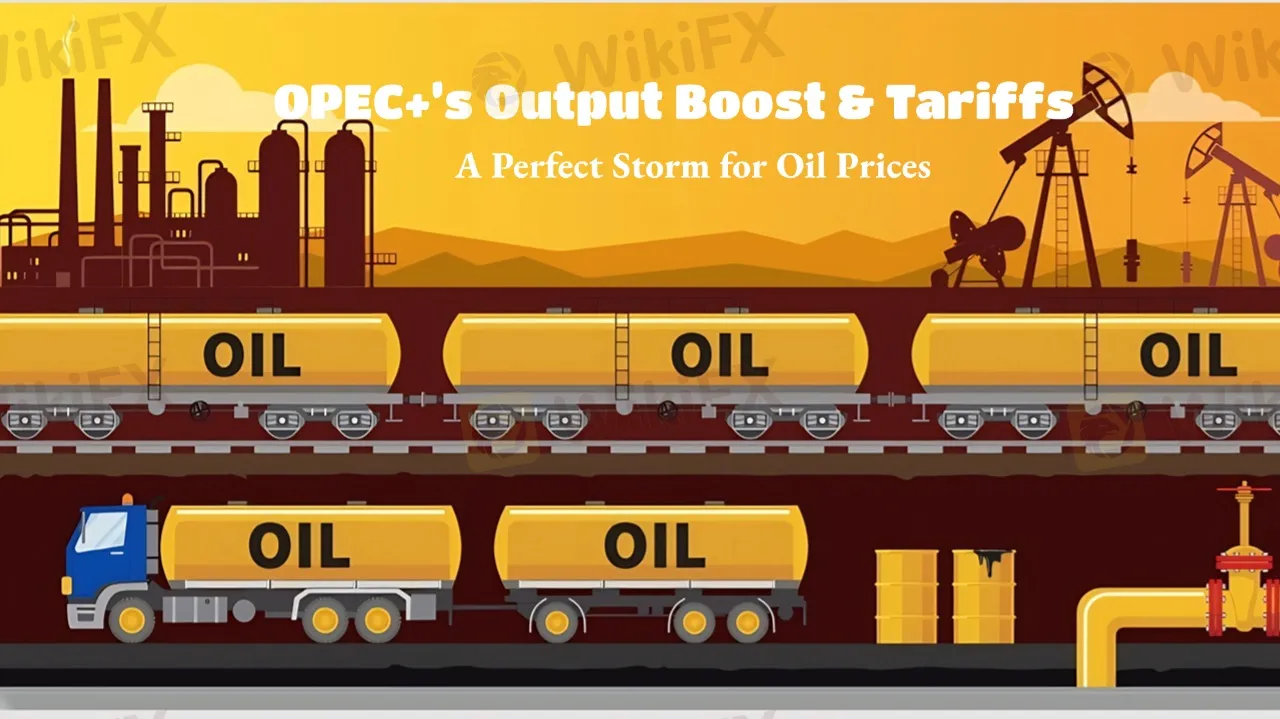简体中文
繁體中文
English
Pусский
日本語
ภาษาไทย
Tiếng Việt
Bahasa Indonesia
Español
हिन्दी
Filippiiniläinen
Français
Deutsch
Português
Türkçe
한국어
العربية
OPEC+’s Output Boost & Tariffs: A Perfect Storm for Oil Prices
Abstract:Oil prices have been on a continuous decline, and with the combined pressure of OPEC+ production increases and tariff policies, the downward trend may persist in the short term.

On March 4, Brent crude briefly fell below the $70 mark for the first time since October last year, while WTI crude dropped below $67, hitting a three-month low.
During Mondays meeting, OPEC+ announced its first crude oil production increase since 2022, planning to raise output by 138,000 barrels per day starting in April.
This decision signals a gradual rollback of the groups previous policy, which had reduced daily production by six million barrels to stabilize the market. This move is expected to further weaken oil price support and heighten the risk of supply-demand imbalances.
Beyond the pressure from increased production, trade policies are also adding to market uncertainty. The Trump administration has imposed a 25% tariff on goods from Mexico and Canada, while raising tariffs on Chinese goods to 20%.
This decision has fueled fears of an escalating global trade war, which could dampen energy demand and exert additional downward pressure on oil prices.
Amid deteriorating supply-demand dynamics, market expectations for oil prices remain pessimistic. Citi forecasts that Brent crude prices may decline toward $60 per barrel over the next three months. Goldman Sachs analysts also warn that with higher-than-expected crude supply, slowing U.S. economic activity, and demand contraction due to escalating tariffs, oil prices face significant downside risks.
Disclaimer:
The views in this article only represent the author's personal views, and do not constitute investment advice on this platform. This platform does not guarantee the accuracy, completeness and timeliness of the information in the article, and will not be liable for any loss caused by the use of or reliance on the information in the article.
Read more

Nonfarm Data Lifts Market Sentiment, U.S. Stocks Rebound Strongly
U.S. nonfarm payrolls for May slightly exceeded expectations, stabilizing investor sentiment and easing fears of a hard landing. This upbeat data sent U.S. equities broadly higher, led by tech stocks, with the Dow and S&P 500 posting significant gains. However, behind the optimism lies a fresh round of market debate over the Federal Reserve’s rate path, with uncertainty around inflation and interest rates remaining a key risk ahead.

OctaFX Flagged by Malaysian Authorities
OctaFX has been officially listed on warning lists by both Bank Negara Malaysia (BNM) and the Securities Commission Malaysia (SC). These alerts raise serious concerns about the broker’s status and whether it is legally allowed to operate in Malaysia.

TradingPRO: A Closer Look at Its Licences
In an industry where safety and transparency are essential, the regulatory status of online brokers has never been more important. For traders seeking to protect their capital, ensuring that a platform operates under recognised and stringent oversight can make all the difference. Keep reading to learn more about TradingPRO and its licenses.

Oil Price Breakout Incoming? Investors Should Stay Alert
Oil prices are hovering around a critical level, with potential yet to be fully unleashed. Investors must prepare for sudden changes.
WikiFX Broker
Latest News
SkyLine Guide 2025 Malaysia: 100 Esteemed Judges Successfully Assembled
Vantage Markets Review 2025: Trusted Forex and CFD Trading Since 2009
Why STARTRADER Is Popular Among Traders?
A Guide to Intraday Forex Trading You Can't Miss Out
CONSOB Blocks Access to 13 Unauthorized Investment Websites
TradingPRO: A Closer Look at Its Licences
The world could be facing another ‘China shock,’ but it comes with a silver-lining
New SEBI Regulations on Intraday Trading
Everything You need to know about Barath Trade
IronFX Broker Review 2025: A Comprehensive Analysis of Trustworthiness and Performance
Currency Calculator


